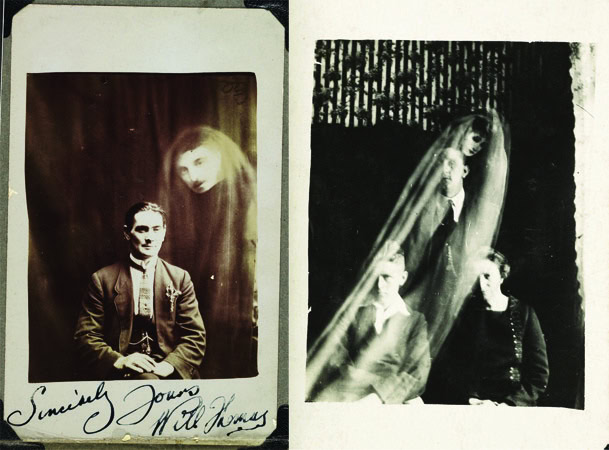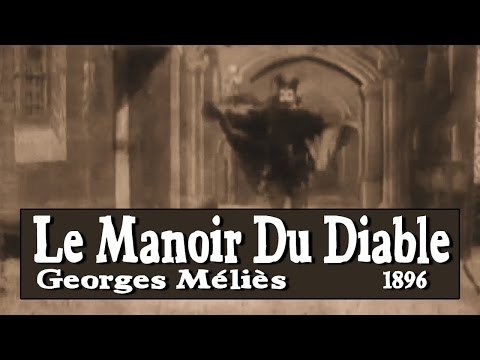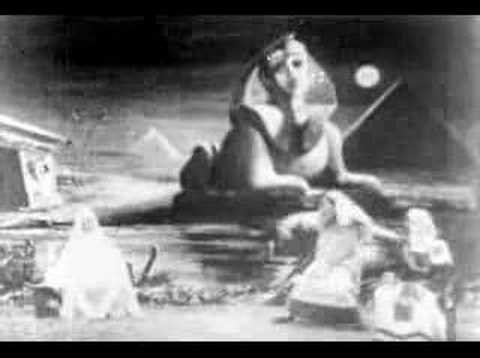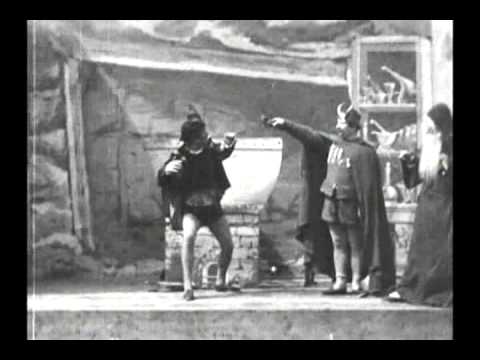On This Page
Entering the Kingdom of Shadows
The first horror movies appear during the very earliest days of cinema, in the 1890s. Indeed, some of the very first moving pictures, simple street scenes, or a train pulling into a station, caused feelings of horror in audiences. There was something distinctly supernatural about the way people were captured on film, flickering through the same few seconds in time for all eternity.
Here’s how Maxim Gorky describes seeing the Lumière Brothers’ “A Street In Paris” 1896:
Last night I was in the Kingdom of Shadows.
If you only knew how strange it is to be there. It is a world without sound, without colour. Everything there — the earth, the trees, the people, the water and the air — is dipped in monotonous grey. Grey rays of the sun across the grey sky, grey eyes in grey faces, and the leaves of the trees are ashen grey. It is not life but its shadow, it is not motion but its soundless spectre. Here I shall try to explain myself, lest I be suspected of madness or indulgence in symbolism. I was at Aumont’s and saw Lumière’s cinematograph — moving photography.
Gorky’s review of the Lumière program at the Nizhni-Novgorod Fair1
For Gorky, and for many others, the cinematograph was a form of dark sorcery. It triggered the imagination in wild, new ways. It captured the everyday and mundane and transformed it into something other-worldly. Gorky found the “eternal silence” of the images disturbing. He was also haunted by his emotional response to early cinema.
It is terrifying to see but it is the movement of shadows, only of shadows. Curses and ghosts, the evil spirits that have cast entire cities come to mind…
This mute, grey life finally begins to disturb and depress you. It seems as though it carries a warning, fraught with a vague but sinister meaning that makes your heart grow faint. You are forgetting where you are. Strange imaginings invade your mind and your consciousness begins to wane and grow dim…
Ibid
Initially, the simple moving images of a street scene described by Gorky were enough to thrill an audience. However, the novelty of watching a straightforward representation of reality wore thin. People wanted stories, with recognizable beginnings, middles, and ends. The new medium of cinema, depicting “the movement of shadows”, seemed perfect for darker narratives with supernatural themes.
So, pioneers like the Lumière Brothers and George Méliès learned how to tweak and manipulate images on film. They created special effects on screen, such as spirits, dancing skeletons, giant creatures, and sudden appearances and disappearances. The supernatural could now appear in the same frame as the natural – and entertain an audience like nothing before.
Capturing Ghosts
These early horror films don’t simply appear out of nowhere. They blend many different art forms of the nineteenth century into the new medium of cinema. The visual aesthetic comes, in many cases, from Expressionist painters. The narrative style comes from the special effects laden-phantasmagoria horror theatre of the 18th and 19th centuries (which utilized sounds, smells and magic lantern projections) and the melodramatic plays of the Grand Guignol Theatre Company. These stage productions were, in turn, adapted from the dark imaginings of Gothic literature.
The first horror filmmakers also adopted some of the tricks used by spirit photographers in the 1860s. Spirit photography – the practice of using double exposures or superimpositions to depict ghosts within a frame of film – was discovered by accident by a Boston photographer, William Mumler in 1861. These photographs were valued by Spiritualists (who may have believed the images were real, vindicating their belief in the afterlife). They were also popular with stage magicians and their audiences, who delighted in fakery as entertainment. Harry Houdini and P.T. Barnum both took delight in exposing(!) the fraudulent images created by their rivals.


At the time, the first horror movies were known as spook tales. The label ‘horror’ isn’t applied to movies until the 1930s. Unfortunately, the fragility of early film stock means that many of the first horror movies have been lost forever. Some, however, survived and are available online.
The Very First Horror Movies (1890s)
The first horror movies were extremely short, a novelty sequence designed to impress an audience rather than tell a story. One of the very first is titled Le Squelette Joyeux. This fragment was created by the Lumière brothers in the mid 1890s (dates vary):
The first horror narrative on record is Le Manoir du Diable (1896), created by the visionary Georges Méliès. Although it has a running time of a little over three minutes, this supernatural story still manages to pack in the genre paradigms. Bats, devils, witches, cauldrons, ghosts, trolls all appear and disappear in puffs of smoke.
Horror Movies of the 1900s
Georges Méliès continued to dominate as undisputed master of the spook tale through the 1900s. In his specially constructed glass studio in Paris, he invented many camera modifications and devices to help bring his fantastical visions to the screen. He’s believed to be responsible for many special effects firsts: split screen, double exposure, overlapping dissolves, fades in and out, and stop motion photography. He also used storyboards and color extensively.
The Monster (1903) mixes Egyptology with necromancy. An Egyptian prince hires a magician to bring his dead wife to life so he can gaze upon her one more time. Against an elaborately painted backdrop showing the Sphinx, her skeleton dances to life, turns into a ghoul, then a beautiful woman, before disintegrating into a pile of bones again.
Faust et Méphistophélès (1903) is quite possibly the first horror movie directed by a woman, Alice Guy.
As the 1900s went on, new developments in projection technology made it possible to tell (slightly) longer stories. This led to the (now, sadly lost) first movie adaptation of Robert Louis Stevenson’s Dr. Jekyll and Mr. Hyde, made by the Chicago-based Selig Polyscope Film Company in 1908.
The first movie version of Mary Shelley’s Frankenstein was made by Edison Studios in New York, in 1910. Thomas Edison and the director, J. Searle Dawley, condensed the novel into a run-time of just 14 minutes. Their press release2 shows that, already, there were certain groups who felt there was something morally wrong with spook tales as entertainment.
To those familiar with Mrs. Shelly’s [sic] story it will be evident that we have carefully omitted anything which might be any possibility shock any portion of the audience. In making the film the Edison Co. has carefully tried to eliminate all actual repulsive situations and to concentrate its endeavors upon the mystic and psychological problems that are to be found in this weird tale. Wherever, therefore, the film differs from the original story it is purely with the idea of eliminating what would be repulsive to a moving picture audience.
Then came the Great War, which changed everything, redefining the visual and psychological language of horror the world over.




